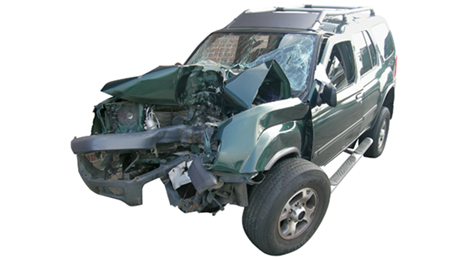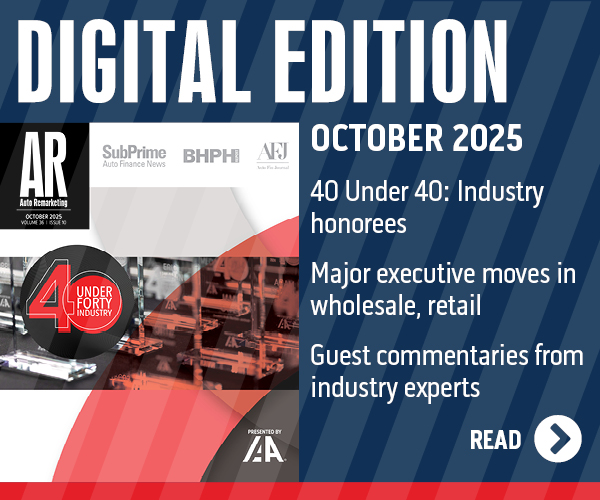CarProof released data Wednesday that may prove interesting to both consumers and dealers alike.
When taking in trade-ins, Calgary dealers might want to take note of the following: According to CarProof data, almost one in three used vehicles have been in an accident or have some type of damage history.
And in the whole province of Alberta, that number only drops to 29 percent.
"We know that when shoppers are looking for a used car, they want to see all the information available on that car before they commit to buying," says Ed Woiteshek, president and chief executive officer at CarProof. "That's why CarProof collects data from sources across Canada and the U.S. and compiles it into one easy-to-read report. We want shoppers to feel confident that they know exactly what's happened to the vehicle in the past so they can make a purchase decision with full peace of mind."
"If the CarProof report does show damage history, that doesn't necessarily mean the car isn't the right fit for you," says Woiteshek. "This information can provide insight into the current safety of the vehicle and with the help of a mechanic, can confirm whether or not any prior damage was properly fixed."
Of course, buying from a licensed dealers can help shoppers avoid nondisclosure of vehicle history and previous accidents.
This news comes after another data assertion CarProof released in 2014. On top of the recent accident statistic, last year the company revealed that more than one-third of the used vehicles in Canada have a lien, or security for debt owing.
The company shared, interestingly, this is a fact that most Canadians are “largely unaware of.”
Canadian automotive dealers have had it with distracted driving and are taking a stand this month.
More than 430 dealerships are participating in the Auto Dealers Against Distracted Driving campaign throughout March, inspired by a countrywide campaign to increase attention and education around this behavior.
According to the campaign, nearly 80 percent of collisions in Canada are caused by some form of distracted driving.
LGM Financial Services Inc. is the initiator and support behind the campaign.
"We feel that the physical act of signing your name as a pledge against distracted driving helps instigate behaviour change and we're excited to see the momentum generated by auto dealers to date," says Christine Rybas, executive vice president of marketing at LGM Financial Services Inc. "Whether it's using hands-free technology while driving or pulling your car over to send a text, we can together bring a heightened awareness to the issue and the solutions, leading drivers toward positive change and ultimately making roads safer for everyone."
In joining the campaign, dealerships cited the importance of bringing more awareness of the issue to consumers directly through their automotive point-of-sale.
"It was a no-brainer for us to participate in the campaign, being the first touch-point for car buyers," says Linda Leo, customer relations manager, West Coast Auto Group. "We care about our communities and more importantly, about the safety of our customers once they leave the lot in a brand new car.
"We believe that part of our responsibility, as a player in the automotive industry, is to ensure we've done our due diligence in educating everyone that walks through our doors around the perils of driving distracted."
To date, more than 1,500 personal pledges have already been submitted at www.distractionfree.ca, from both employees at participating dealerships and their customers.
LGM Financial Services management said the goal at the close of the campaign on March 31 is to surpass at least 5,000 pledges from dealer partners, their customers and members of the public against distracted driving in every province and territory, collectively.
I’m a passionate guy. Aside from the obvious loves of my life (my children, wife and family), I’ll admit that I’m one of those guys that loves his job — engaging in the game of the used-car sales industry. I also love sports — especially golf and hockey.
I’m not a very good hockey player and I am a Maple Leafs fan, so it’s probably best to not get into a discussion about hockey. Let’s talk about golf, instead.
In 2006, my love of the art of the golf swing reached its peak — because of a commercial (of all things). The commercial was called “Swing Portrait” and it was for Nike (you should look it up if you get the chance). It showed Tiger Woods taking a golf swing in super-slow motion, and featured the smooth sound of a cello solo playing in the background.
In a word, the commercial was breathtaking. The true art of golf was displayed so poetically in that single minute commercial. From that moment on, I was hooked on creating a swing for myself that looked exactly like the swing of Tiger Woods.
This was not an easy task as, at the time, my swing looked like a mix of Jim Furyk’s and Charles Barkley’s golf swings.
Eight years later, I still don’t swing like Tiger Woods, but along the way I realized something — no one swings like Tiger Woods. Tiger doesn’t even swing like he did back in 2006.
However, if you look at the top 100 golfers in the world, although no two swings are alike, they all involve the mastering of certain fundamental traits (in the case of golf, those traits include things like square impact, good balance and proper follow through).
If I wanted to improve my golf swing, I had to learn that I wasn’t going to get there by standing in front of a mirror all day, trying to move my body exactly like Tiger did in that commercial. I needed to first study the fundamental traits that are common to the most successful golfers, and then to figure out how to master those traits — in my own way. I needed to be able to create my own unique swing.
In the world of used-car sales, you are always striving to improve. How do you get to the top? Do you try to mimic specific things that the top dealers are doing? Or do you try to study the patterns in the fundamental traits that all of the top dealers have — and then try to master those traits in your dealership — in a customized way? I’d suggest that you need to do the latter.
Luckily, there is a lot of information that is shared on what the top 10 percent of dealers are doing, and how they are doing it. And I can assure you, they all do it in their own unique way. Instead of mimicking their unique way, try to focus on the fundamental traits that all successful used-car dealerships master.
Those traits include the following:
- High inventory turn rate
- Use of metric-based acquisition and retailing (primarily using data in order to make decisions about buying and selling prices, instead of primarily using gut instinct and self-interested wholesalers)
- Effective and efficient reconditioning and marketing/advertising
- Staff that is well-trained on internal processes and procedures
Once you understand the key traits, you will then have the foundation to try and figure out how to master those traits in your particular dealership, and in your own unique way. Just because a particular top dealership uses fixed pricing to achieve high inventory turn rate, that doesn’t necessarily mean that if you start using fixed pricing, you’ll reach the top as well.
That said, you will start seeing improvements to your bottom line if you figure out the most effective way for your particular dealership to achieve high inventory turn rates (and the other fundamental traits).
By taking the time to study, implement and master the fundamental traits shared by the top dealerships, instead of trying to jump on what you think is the “quick win” train of mimicking, you’ll ensure that your foundation is strong and resilient. This will allow you to change with the market, adapt to modern selling methods, stay current and always continue moving forward.
There’s a saying in golf: “You don’t beat the game of golf, you only play it.” Keep this in mind when you are going through a rough patch or struggling to transform your used-car department.
Even the best dealer in the world is looking to do better — to accomplish more — and improve from the year before.
Remember, it all starts with you.
Richard Macdonald is the founder of RPM Solutions. Richard provides consulting, training and coaching services to new-car franchise stores to help them maximize their used-car department profits. For more information, contact Richard at 416-894-1475 or [email protected], or visit www.rpmsolutions.ca.
Curbsiding — something you don’t have to worry about as a licensed dealer? Wrong.
The Ontario Motor Vehicle Industry Council recently issued a bulletin that warns dealers against supplying curbsiders, because you may be held accountable.
Take this situation for example:
A London, Ontario, dealer was recently convicted of supplying vehicles to a curbsider. The dealer — Waldemar Krzynowek, owner and proprietor of Val Car Sales and Service — was found to be in violation of section 4 (4) of the Motor Vehicle Dealers Act (MVDA).
The section states, “A motor vehicle dealer shall not supply motor vehicles to another motor vehicle dealer for the purpose of trading in motor vehicles unless the other motor vehicle dealer is registered in that capacity.”
Krzynowek was fined $7,500 for supplying a 2006 Acura to an alleged curbsider. And the dealer was fined another $1,500 for failing to ensure a purchased received a copy of the contract.
OMVIC reported the Acura had previous accident damage exceeding $35,000. Often, curbsiders will resell the unit without disclosing accident history.
The alleged curbsiders in the case, Grzegorz and Ryszard Kowalski, were also charged and are currently before the courts, OMVIC pointed out.
Though it is easy to assume curbsiding only posed a direct threat to consumers, it is evident the practice impacts the industry as a whole.
In an effort to aid licensed dealers, the OMVIC bulletin included a list of ways to avoid selling to curbsider, which includes:
- Registering all vehicles in the buyer’s name
Curbsiders commonly won’t register vehicles in their names. They may offer to do the transfer themselves but will keep the vehicle in the selling dealer’s name until it’s sold to an unsuspecting buyer. Ensure all vehicles sold are registered in the name of the buyer before the vehicle is released.
- Verify that dealer is registered with OMVIC
If a buyer claims to be from another dealer or wholesaler, verify their registration on OMVIC’s website or ask to see their OMVIC licence. By law, they must present it to anyone asking to see it. If they can’t produce one, don’t conduct business with them and report them to OMVIC.
- Regularly review Garage Register
Conduct periodic checks of the Garage Register. Does the same name appear numerous times? Can it be explained? Be vigilant.
The Used Car Dealers Association of Ontario also touched on this topic in its latest Front Line newsletter. The UCDA offers their own list of red flags that should alert dealers they might be about to sell to a curbsider.
According to the UCDA, obvious indicators are buyers who:
- Do not want you to register the vehicle into their name, but prefer to just take the permit (ownership) from you
- Want to deal in cash, “off the books” with little or no paperwork
- Will appear more knowledgeable about the buying process than most ordinary consumers
- Have no intention to plate the vehicle
- Will own the vehicle for a very short time during which they will sell or flip it
- Come back for more cars on a regular basis or buy multiple cars all at once
AutoGO.ca now offers a new tool for gauging theft frequency that could benefit both dealers and their consumers.
The theft frequency estimator, developed by the website in conjunction with National Bank Insurance Auto | Home and Adviso Conseil Inc., is integrated into the used-car listings on AutoGO’s website to help buyers looking for a car in the Quebec area visualize the likelihood of theft of the vehicle they’re interested in.
The tool could also be useful for dealers who have listings on the site, making them aware of the probability of theft, not only from a purchaser’s point of view, but also for the safety of the vehicles on their lot.
With the unfortunate reality of how theft rates positively correlate with insurance rates, the theft frequency estimator is another method to help decide which vehicles are worth listing and maintaining in dealer stock.
Dominic Caron, the marketing manager for National Bank Insurance Auto | Home, hopes the tool will help automotive customers gauge their finances.
“Damage, such as theft, generally impacts the insured’s premium,” Caron said. “The theft frequency estimator gives consumers an additional tool to assist them in making well-informed decisions when managing their insurance budget.”
The national car theft rates which power the estimator are based on data from the Insurance Bureau of Canada.
The Canadian branch of the International Automobile Remarketers’ Alliance completed its first training event earlier this month for its members — an event the organization said was well-attended by members “from all facets of the automotive remarketing spectrum.”
The event was held at ADESA Toronto on May 7 and featured a variety of programs designed to help organizations and individuals in their remarketing efforts.
The theme of the program was “Remarketing 101,” and the curriculum was devised in order to provide an understanding of various aspects of selling vehicles at auctions.
“IARA Canada has been studying various training initiatives since its inception, and it was clear from our members that a great opportunity to launch our training program was for those in remarketing roles, or with roles that remarketing effects, whom may not have a fulsome understanding of entire remarketing chain-of-events,” said Josh Bailey, Canadian Black Book vice president, research and editorial, and IARA committee member.
Bailey told Auto Remarketing Canada attendee feedback was all very positive.
“Even though some admittedly had experience with wholesale auctions, everyone walked away with new information,” he added.
The day included presentations from Claudio DeAngelis of Foss National Leasing and Gerry Corcoran of Jim Pattison Leasing. These presentations explored the numerous avenues a remarketer can take when selling vehicles that have been returned to them.
Steve Coulman, Manheim Canada; Steve Langdon, Adesa Canada; and Josh Bailey Canadian Black Book, were also on hand “to provide insight from their experiences and how their various valuation tools can help in the remarketing process,” IARA officials explained.
The event also featured what the IARA coined the “Appraisal Callenge.”
Here’s how it worked:
The participants were asked to predict the value of seven vehicles sold that day using their skills learned from earlier presentations.
Four teams recorded their estimates, and these were compared to the sales results from the auction block.
“The ‘Appraisal Champions’ walked away with bragging rights but all left with a better understanding of the workings of an auction and remarketing,” organizers noted.
IARA Canada will offer its members the Remarketing 101 course again this fall.
“We are looking at how to elaborate upon it to help further deepen remarketing skills; this means additional courses could be added,” Bailey said.
He explained IARA Canada is also looking into plans to adapt the IARA certification process already offered in the U.S. for the Canadian branch.
“The review of that process is underway and there are plans for several Canadian IARA members to complete the U.S. certification in order to precisely identify areas that require Canadian-specific changes,” Bailey said. “Vehicle registration processes is just one example of an area that will need adaptation for Canada.”








